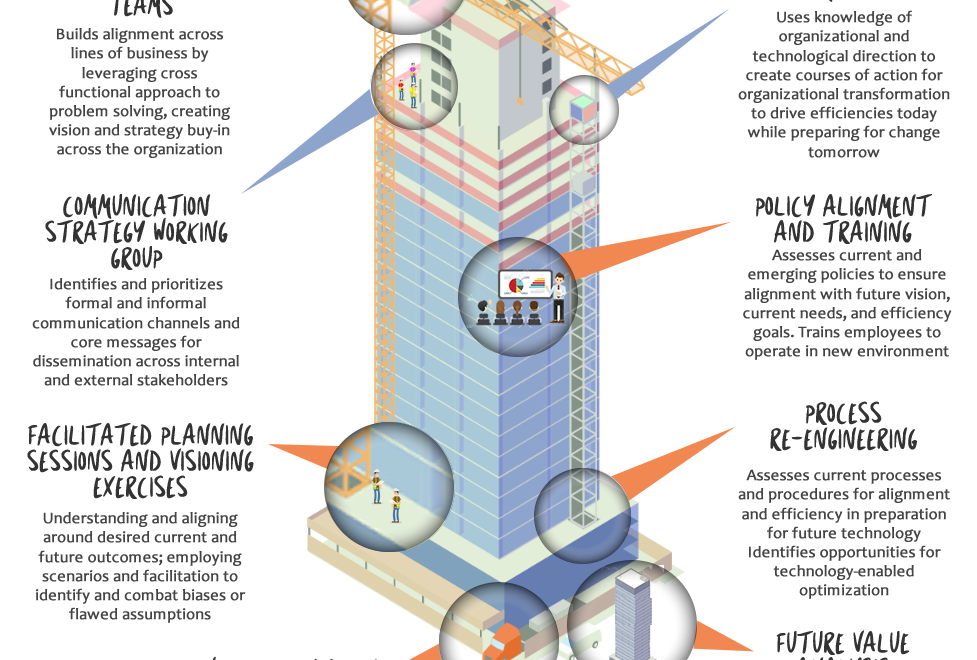Is Your Organization Prepared to Adopt Disruptive Technology?

Every day, powerful new technologies like Blockchain, Artificial Intelligence, automation, and robotics are emerging and forcing leaders to rethink their organization and to consider a host of unknowns for their future. They’re coming into the marketplace faster than ever, are increasingly complex, and are disrupting how many institutions operate. It’s not surprising that many leaders struggle to understand how to engage new resources, how to introduce and explain them to their people – and even whether they should.
They should.
Not only are many of the emerging technologies here to stay, but they are also rapidly becoming ubiquitous – skipping right past competitive advantage to be a ‘way of operating’ for companies of all sizes around the world. It’s a situation that demands leaders deftly straddle the processes of planning for future operational excellence while sustaining market value today.
A Modern Change Management Approach to Securing Today and Tomorrow
Change management is a fundamental part of modern business. During inflection points like we see now, in which organizations are tasked with adopting new tools for managing information, people, and assets, it takes on a greater role. In its most practical terms, change management begins with identifying challenges and opportunities on a continuum of hindsight, insight, and foresight.
- Hindsight: What is happening?
-
- Past-focused, accounts for business intelligence, etc.
- Insight: Why is it happening?
-
- Business analysis, trend assessments, etc.
- Foresight: What will happen? What should happen?
-
- Predictive analytics, forecasting, future-focused
This exercise helps to clarify what is happening and why, as well as what is coming, allowing the organization to get a clearer sense of which new technologies will equip them to build value (and which will not). With that in mind, they can focus on what people, information, methods, and other changes will drive toward immediate and lasting value. It is a constant cycle of evaluating, understanding, planning, and iterating that simultaneously prioritizes the immediate and the future state of the organization.
Strengthening Efforts and Growth-Focused Efforts
Most organizations become overwhelmed by the range of possible decisions to make in preparation for the future. To mitigate the risk of taking an overly farsighted view, organizations must connect their long-term vision with their short-term demands. This parallel focus works on a time continuum to establish a transitional strategy that puts guideposts in place for short, mid-, and long-term success.
Establishing this clear vision and executable plan is not inherently difficult, but does require purposeful and objective strategy development and a consistent hand during implementation.
Recognizing that decisions focused on immediate challenges and those focused on future challenges can often seem in conflict, leaders must first establish a framework for understanding the differences and relationships between strengthening efforts and growth-focused efforts.
- Strengthening efforts live in hindsight and insight. What is happening and why, and how do we need to address it now?
- Growth-focused efforts are aligned with foresight. What will happen and how can we work toward the optimal outcomes?
The two endeavors should work in complement to each other as core elements of a deliberate transformation strategy. Provided that the vision is clearly defined and communicated across the organization and among its stakeholders, a shared understanding of the journey, and integrated change management support efforts in both categories, the efforts can drive value across immediate, mid, and long-term time horizons.
Strengthening Efforts
Activities in the strengthening category are designed, implemented, and aligned to create and protect value today. Strengthening efforts might include:
- Process and policy re-engineering
- Policy alignment and training
- Assessing and optimizing current workforce models
- Metric or KPI establishment
While ostensibly focused on their immediate value, strengthening efforts lay the groundwork for future, growth-oriented efforts through exercises like Future Value Analysis.
Growth-focused Efforts
Any organization striving to FUTURE PROOF® its people, processes, resources, and institutional structures has an eye – and a team – trained on future changes and market disruptions. These efforts are designed for strategic alignment, solidifying culture and innovation, and building increase agility. They might include:
- Building Tiger Teams of cross-functional experts
- Deliberate internal and external communications efforts
- Future organizational design
These endeavors are parallel tracks with many nexus points. The teams, goals, and activities are interdependent. Together, they help organizations make sense of a complicated future, and determine the extent to which changes can be gradual or sweeping. They encourage operational alignment and structure the organization to prepare for and thrive in a changing market with new technologies and changing customers. And they clarify the role each individual plays in achieving near-, mid- and long-term outcomes through the process of adopting, learning, and engaging relevant new technology resources.
It’s time to define and align critical steps that you can take to create and protect value today and in the future.
{{cta(‘bc9ba0a2-ec02-401a-8b7c-a568db3188ce’)}}
- Categories
- Technology & Innovation Readiness


 About the Authors
About the Authors